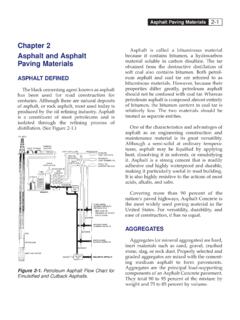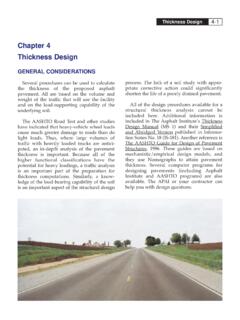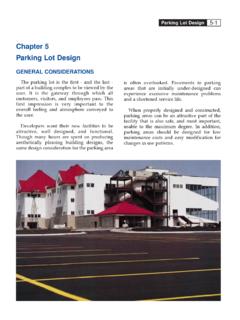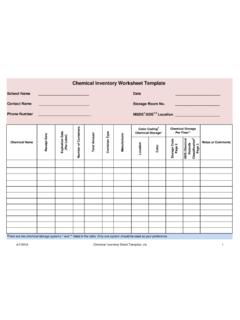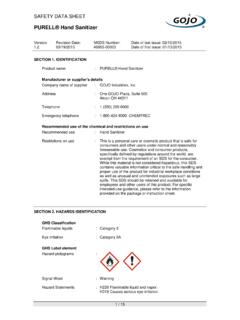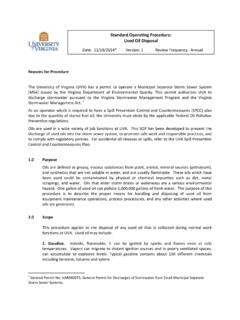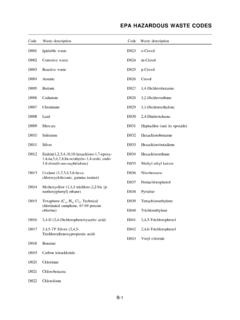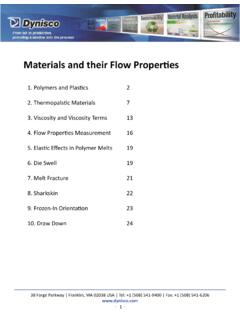Transcription of Chapter 2 Asphalt and Asphalt Paving Materials
1 Asphalt Paving Materials2-1 Asphalt Paving Materials2-1 Chapter 2 Asphalt and Asphalt Paving MaterialsASPHALT DEFINEDThe black cementing agent known as asphalthas been used for road construction forcenturies. Although there are natural depositsof Asphalt , or rock Asphalt , most used today isproduced by the oil refining industry. Asphaltis a constituent of most petroleums and isisolated through the refining process ofdistillation. (See Figure 2-1.) Asphalt is called a bituminous materialbecause it contains bitumen, a hydrocarbonmaterial soluble in carbon disulfate. The tarobtained from the destructive distillation ofsoft coal also contains bitumen.
2 Both petrol-eum Asphalt and coal tar are referred to asbituminous Materials . However, because theirproperties differ greatly, petroleum asphaltshould not be confused with coal tar. Whereaspetroleum Asphalt is composed almost entirelyof bitumen, the bitumen content in coal tar isrelatively low. The two Materials should betreated as separate of the characteristics and advantages ofasphalt as an engineering construction andmaintenance material is its great a semi-solid at ordinary tempera-tures, Asphalt may be liquified by applyingheat, dissolving it in solvents, or emulsifyingit. Asphalt is a strong cement that is readilyadhesive and highly waterproof and durable,making it particularly useful in road is also highly resistive to the actions of mostacids, alkalis, and more than 90 percent of thenation s paved highways, Asphalt Concrete isthe most widely used Paving material in theUnited States.
3 For versatility, durability, andease of construction, it has no (or mineral aggregates) are hard,inert Materials such as sand, gravel, crushedstone, slag, or rock dust. Properly selected andgraded aggregates are mixed with the cement-ing medium Asphalt to form are the principal load-supportingcomponents of an Asphalt Concrete total 90 to 95 percent of the mixture byweight and 75 to 85 percent by Asphalt Flow Chart forEmulsified and Cutback Paving Materials2-2 ClassificationsAsphalt Concrete Paving aggregates areclassified according to source or means ofpreparation. Abrief description of the classifi-cations or Bank-Run AggregatesBoth gravel and sand are typically pit orbank-run natural aggregates.
4 They usually arescreened to proper size and washed to removedirt before being used for Asphalt Concretepaving AggregatesWhen natural pit or bank-run aggregate hasbeen crushed and screened to make it suitablefor Asphalt Concrete pavements, it is consider-ed a processed aggregate. Crushing typicallyimproves the particle shape by making therounded particles more angular. Crushing alsoimproves the size distribution and stone is also a processed is created when the fragments of bedrockand large stones are crushed so that all particlefaces are fractured. Variation in size of particlesis achieved by screening. Aggregates that havereceived little or no screening are known ascrusher run.
5 These aggregates are generallymore economical than screened aggregatesand can be used in Asphalt Concrete pave-ments in many the processing of crushed limestone, therock dust produced is separated from the othercrushed aggregate and may be used as crushedsand or as a mineral filler in Asphalt Paving Materials2-3 Synthetic AggregatesAggregates produced by altering bothphysical and chemical properties of a parentmaterial are called synthetic or artificialaggregates. Some are produced and processedspecifically for use as aggregates; others arethe byproduct of manufacturing and a finalburning process.
6 Blast furnace slag is anexample of a synthetic Properties of AggregatesSelection of an aggregate material for use inan Asphalt Concrete pavement depends on theavailability, cost, and quality of the material , as well as the type of construction for which it is intended. To determine if an aggregatematerial is suitable for use in Asphalt construc-tion, evaluate it in terms of the followingproperties:1. Size and maximum size of anaggregate is the smallest sieve throughwhich 100 percent of the material will the Asphalt Concrete is to be useddetermines not only the maximum aggre-gate size, but also the desired gradation(distribution of sizes smaller than themaximum).
7 2. or deleterious sub-stances make some Materials unsuitable forpaving or hardness is theability of the aggregate to resist crushing ordisintegration during mixing, placing, andcompacting; or under traffic similar to toughness,soundness is the aggregate s ability to resistdeterioration caused by natural elementssuch as the Particle shapes of aggregateparticles influence the Asphalt mixture soverall strength and workability as well asthe density achieved during compacted, irregular particles suchas crushed stone tend to lock togetherand resist Surface and pavementstrength are influenced by surface texture.
8 Arough, sandpapery texture results in ahigher strength than a smooth smooth-faced aggregates are easyto coat with an Asphalt film, they aregenerally not as good as rough surfaces. It isharder for the Asphalt to grip the porosity of an aggregatepermits the aggregate to absorb Asphalt andform a bond between the particle and theasphalt. Adegree of porosity is desired, butaggregates that are highly absorbant aregenerally not the Asphalt film separatesfrom the aggregate because of the action ofwater, it is called stripping. Aggregatescoated with too much dust also can causepoor bonding which results in readily susceptible to strippingaction usually are not suitable for asphaltASPHALT BINDERTYPE OF CORRIDORLOCATIONTYPE OF MIXPG 70-22 Heavy DutyFull Depth AsphaltSurface Mixture (sp125 or SMA)
9 AndClass V-VIfirst underlying liftsPG 64-22 Remaining liftsPG 70-22 Asphalt OverlaysAll MixturesPG 64-22 Medium DutyFull DepthAll MixturesClass III-IVand OverlaysPG 64-22 Light DutyFull DepthAll MixturesClass I-IIand OverlaysAsphalt Paving Materials2-4paving mixes unless an anti-stripping agentis CEMENTA sphalt is produced in a variety of typesand grades ranging from hard-brittle solids tonear water-thin liquids. The semi-solid formknown as Asphalt cement is the basic materialused in Asphalt Concrete pavements. Liquidasphalt is produced when Asphalt cement isblended or cut back with petroleum distillatesor emulsified with water and an emulsifyingagent.
10 Liquid Asphalt products may be pro-duced for various uses and of the types and characteristics ofasphalt are noted in the following Types, Characteristics and General *(Min)Cutback(Min-Max)(Min) UsesSS- 157 Water 43100-20070- 160 TackSS-1 H57 Water 4340-9070- 160 Tack, Slurry Surface TreatmentCSS- 157 Water 43100-25070- 160 TackCSS-1 H57 Water 4340-90 Boils70-160 Tack, Slurry Surface TreatmentRS-155 Water 45100-200 Over70-140 Bituminous Seal CoatRS-263 Water 37100-200at125-185 Bituminous Seal CoatCRS-160 Water 40100-250180 F125-170 Bituminous Seal CoatCRS-265 Water 35100-250125-170 Bituminous Seal Coat viscosityRC-7055 Naphtha 4570-14080 FTackMC-3055 Kerosene 45120-250100 F70-150 PrimeMC-7055 Kerosene 4570-140100 F145-165 Bit.
